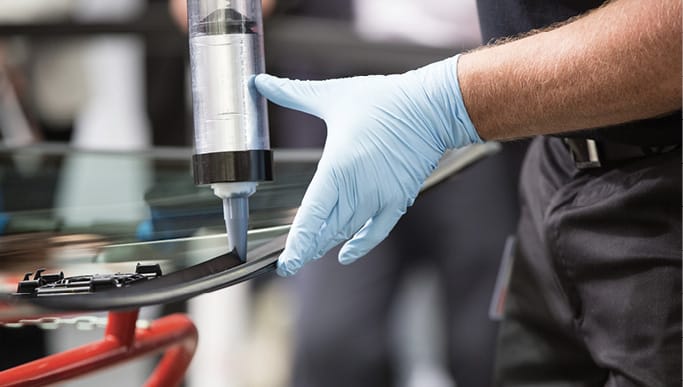6.3.2 1c and 2C SMP Compositions
A 1C SMP adhesive cures using the moisture in the air, while 2C systems cure via an added water paste as a second component. This system makes 2C SMP adhesives cure much faster than 1C systems, independent of environmental relative humidity.
19) Proebster, Manfred. Industrial sealants. Landsberg am Lech, Germany: Verlag Moderne Industrie, 2004
20) Austerberry, Michael. ‘Silane-Modified Polymers (SMP) Combining the Best of Silicone & Organic Polymers.‘ International Silicone Conference –May 17, 2016. 2016. 1-25.
6.3.3 Polyurethane (PU)
PU adhesives derive from the presence of the chemical group urethane in the formulated or cured product.21 PUs possess the widest range of curing rates, processing flexibility and mechanical properties due to the versatility of PU chemistry. PUs offer outstanding adhesion to substrates containing hydroxyl groups, such as wood and wood-derived materials, brickwork, concrete and certain plastics and paints. However, substrates such as glass, aluminium and alkaline substrates need primers to develop a strong bond. In addition to promoting adhesion, primers protect the adhesive from negative interactions with the substrate.
Because of their ease of use and low cost, 1C PU sealants have almost entirely replaced 2C polysulfide sealants in the construction industry. The continuous temperature resistance of PU sealants is generally 90°C (194°F), which is adequate for many industrial commercial and residential applications. Some grades can change colour to pale yellow and become brittle when exposed to UV light for a long duration; this often manifests as cracking and a ‘chalky’ powder on the surface. However, some grades can overcome this disadvantage. In their fully cured state, PU sealants are highly resistant to water and aqueous salt solutions, even at high temperatures, but they can be permanently damaged by strong bases and acids. Many polar organic solvents give rise to reversible swelling and, in turn, to a change in mechanical properties. Since the resistance of a sealant to media also depends on the geometry of the joint and other external factors, tests must usually be carried out to ensure the suitability of a product for a particular application.22
The solvent content of most PU sealants improves flow characteristics by lowering their viscosity and in many cases, improved wetting of the substrate occurs, subsequently improving adhesion. The disadvantage of a relatively high solvent content (up to 15%) in many PU sealants is pronounced shrinkage, which becomes apparent during curing. This may cause distortion in the final assemblies, and the sealant may develop internal stresses.
PU sealants lend themselves particularly well to coating with 1C or 2C varnishes and paints containing solvents. Many 1C paints are also based on PU chemistry and are therefore highly compatible with the sealant. With the wet-on-wet method, the paint can be applied directly over uncured PU sealant and both sealant and paint can cure together. However, 2C paints are highly resistant to the diffusion of moisture, which can retard the curing of the sealant. Unlike many other sealing systems, PU sealants can readily be painted when fully cured. The paintability and low cost of PU sealants are advantageous for the transport industry, vehicle manufacturers and vehicle repair shops.
If the cure speed of 1C PU sealants is inadequate, 2C products can be used. The base resin and isocyanate hardener are supplied in separate packages and must be intensively and evenly mixed before use so that a homogeneous curing sealant is obtained.
21) Proebster, Manfred. Industrial sealants. Landsberg am Lech, Germany: Verlag Moderne Industrie, 2004, 37.
22) Proebster, Manfred. Industrial sealants. Landsberg am Lech, Germany: Verlag Moderne Industrie, 2004, 37-40.
Glazing Technology (DGX)

Today’s automotive windscreens or windscreens are installed exclusively using the direct glazing method, building on the technique first used in 1960. Since then, this method has become the standard procedure for cars, buses, trucks, trains and many other vehicles.
The bonded windscreen is now a safety-critical component of vehicles; it ensures the full functionality of the safety restraint systems and airbags. In addition, the windscreen enhances the torsional rigidity of the car body by up to 40%. Furthermore, many new driver assistance systems such as distance sensors, cameras, head-up displays and rain sensors are integrated into the windscreen area of automobiles.

